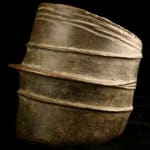Ekonda Copper Alloy Konga Currency Anklet, 19th Century CE - 20th Century CE
Copper Alloy
4.5 x 4.75 x 4.75
CK.0344
Further images
Before the introduction of coinage into sub-Saharan Africa, many peoples crafted sculptural objects out of precious metals that functioned as currency of sorts. It is important to note that they...
Before the introduction of coinage into sub-Saharan Africa, many peoples crafted sculptural objects out of precious metals that functioned as currency of sorts. It is important to note that they were rarely, if ever, used in routine transactions, but instead served as repositories of wealth that were simultaneously aesthetically pleasing. While the forms of these currency sculptures are as varied as the cultures that created them, among certain tribes, including those that inhabit the Congo River region, these works take the shape of wearable jewelry that can be easily transported. Surely, as with all cultures, such jewelry also allowed the wearer to display their wealth and taste, if so desired. The Ekonda are noted for their copper alloy currency anklets and bracelets, which they call konga. These heavy pieces were created by pouring the molten metal into a cast in the ground, known as a puddle mold. As the metal began to cool, the artist began to curve the flat piece into a circular shape, sometimes even fitting it directly on to the wearer’s body. Decorated with ridges and incised lines, the exterior was finally polished.





